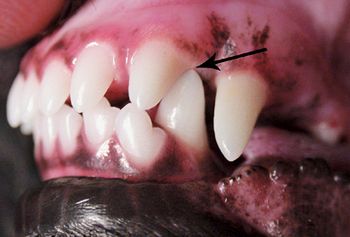
Cats are different! Being obligate carnivores, they do not have chewing teeth, but instead have carnassial teeth that aid to cut up their food into manageable pieces.

Cats are different! Being obligate carnivores, they do not have chewing teeth, but instead have carnassial teeth that aid to cut up their food into manageable pieces.

The term prophylaxis originates from the original Greek, and means to guard or prevent. It applies to any medical term or public health procedure whose purpose is to prevent, rather than treat or cure disease.

This presentation will summarize the seven disciplines of dentistry, and familiarize the attendee with exodontics, periodontics, endodontics, orthodontics, prosthodontics, restorative dentistry, and oral surgery.

How important is oral hygiene? Just imagine what it would be like if you never brushed your teeth.

Diamond is a 12-year-old female spayed Dalmatian that was presented for swelling under the left eye for a two-week duration.

The implementation of veterinary dentistry is increasing in both private and specialty practices. More responsibility is being delegated to the technician, and the expansion of this service relies heavily on a well trained and informed staff.

Keep things clean when peforming dental prophys with this reader tip.

Recently, a group of veterinary dental specialists, most of them members of the Veterinary Oral Health Council (VOHC), came together to discuss the role of the VOHC for both the veterinarian and the consumer.

Becoming familiar with the fundamentals of oral cytology can be invaluable.

Two case examples display how radiography can reveal hidden pathology.

Local anesthesia is employed prior to all dental procedures. Dental procedures can be very painful. The patient often can feel dental procedures while under inhalation anesthesia.

Oronasal fistulae (ONF) are communicating tracts between the nasal cavity and the mouth. The patient presents with continual nasal drainage of fluids and mixed particles of food discharged through the nose.

There are many techniques currently employed for Mandibular fracture repair. They range from simple tape muzzle placement to various forms of invasive surgical reduction. Surgical reduction techniques include intra oral wire cerclage or ligation, osseous plating, inter medullary pining to extra-oral fixation appliances or combinations thereof.

There are many techniques currently employed for Mandibular fracture repair. They range from simple tape muzzle placement to various forms of invasive surgical reduction. Surgical reduction techniques include intra oral wire cerclage or ligation, osseous plating, inter medullary pining to extra-oral fixation appliances or combinations thereof.

What began as an astute observation by a very sharp dental technician has resulted in discovery that the mandibular symphysis of the cat is very easily and frequently separated.

Dental materials and their applications are the most rapidly evolving developments in both human and veterinary dentistry. The varied applications of dental composites in veterinary dentistry beyond their use in human dentistry are cutting edge innovations.

Being aware of dental formulas, oral anatomy as well as terminology is crucial to proper charting.

For small pets, such as most domestic rabbits, guinea pigs, chinchillas, and hedgehogs (the exceptions being ferrets and large rabbits), intubation is generally not an option given the equipment available at most veterinary hospital.

The etiology of dental malocclusion in dogs and cats has been explored to a large degree in recent years due to the strong emphasis on veterinary dentistry.

Teeth are extracted for a number of reasons. These include periodontal disease, caries, advanced feline dental resorptive lesions apical abscesses, traumatic malocclusion, tooth root fracture, tooth crown fracture, retained deciduous, teeth, root tips, supernumerary teeth and client preference.

Periodontal disease begins as an infiltrate subjacent to the epithelium of the gingival margin and rapidly extends throughout the marginal gingiva to affect the connective tissue underlying both the oral and the sulcular epithelium. In addition, there are pathologic alterations of both the sulcular and the oral epithelium of the marginal gingiva.

Don't let dental recommendations go in one ear and out the other. Present a unified, consistent front so pet owners will get the message.

A few these tips for these handy dental tools.

While an uncommon option, odontoplasty can resolve some cases.

Which agents are good choices for use in regional nerve blocks?